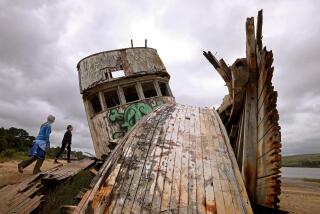Pulling Together in Time of Crisis
VENTURA â They responded on a momentâs notice. And throughout the long, dark night, a flotilla of Ventura County boaters searched the choppy seas off Anacapa Island for survivors of Ventura Countyâs gravest disaster at sea in living memory.
Squid boats burned powerful lamps as Coast Guard crews scoured the roiling ocean for the 88 people who fell from the sky in Alaska Airlines Flight 261. Fishing boats trolled the tight circle of debris. Excursion craft braved 15-foot swells.
Even as day broke Tuesday, at least two dozen small boaters remained at sea--refusing to give up their hunt for those men, women and children who probably died after a terrifying descent into the Santa Barbara Channel on Monday afternoon.
By nightfall, only bodies had been found.
But for Coast Guard officers who led the rescue effort, those first heartbreaking 24 hours remain a shining moment for a fraternity of Ventura County boaters who sometimes compete for jobs, but pull together in times of crisis.
âIt was just an incredible response from the commercial and private boats,â said Capt. George Wright, commander of the Los Angeles Coast Guard district. âIt was just astounding. I watched private vessels come up to the dock carrying debris.â
It is nothing new for boaters to respond when the ocean threatens.
Three Oxnard fishermen risked their lives to try to rescue a Vietnamese colleague two years ago. Solitary urchin divers regularly get into trouble and depend on their competitors to pull them to safety.
âWhen you live on the ocean, spend more time on the ocean than not, you feel protective of it,â said Brian Riley, 38, who runs two squid boats out of Channel Islands Harbor in Oxnard. âThis is a special place, and if something bad happens, you want to fix it.â
Several other squid boats raced south from Santa Rosa Island on Monday night, Riley said, giving up a lucrative night of fishing to join the search although the crash site was four hours away.
For Rick Purschell, a 36-year-old Port Hueneme fishing boat captain, the crash scene was emotionally disturbing. He found a sea of wreckage, body remains and several pairs of shoes.
âIt was not right,â Purschell said. âIâm a fisherman, and Iâm not used to that.â
But he returned before dawn Tuesday to continue the search.
Purschell said his father, who was also a fisherman, used his boat many years ago to help with a plane crash off the coast of Los Angeles.
âIf itâs going to help the families,â he said, âIâd stay out there 24 hours a day.â
There is tragic irony too in the response of local fishermen. Struggling just to stay in business because of a temporary ban on rock fishing, several made enough money from ferrying reporters Monday and Tuesday to make their monthly boat payments.
At least seven boats were hired out of Ciscoâs Sportfishing in Oxnard on Tuesday morning.
Some fishermen who normally earn $650 a day were charging $300 an hour to tote reporters to the crash site.
âIâm sure itâs going to help in an awful way,â said Ciscoâs bookkeeper, Ali Schaal.
Steve Kelly, a Ventura fisherman, volunteered his 45-foot sportfishing boat Monday night to look for survivors. On Tuesday morning, he charged reporters $900 to take them nine miles to the wreckage.
âIf it werenât for the plane crash I would be playing golf today and losing $1,000,â said Kelly, who catches rockfish.
Dave Searles, 31, of Huntington Beach said âDateline NBCâ hired his boat for three days at $2,500 per day.
âIn some ways, this saved a lot of guys,â said Searles, who spent Monday night pulling clothing, shoes, seat covers, seats, trays and body parts from the rough sea.
âThe plane just splintered apart; the pieces are like this,â he said, holding up a package of playing cards.
But for many of the boaters there was no money for a search spread over two days.
Squid fisherman Riley, a Ventura native, was paying slip fees at 6 p.m. Monday when harbor patrol officers asked for help. He took his two boats with glaring searchlights--the wooden 35-foot Moonshiner and the fiberglass 32-foot Ira/S--to the crash site.
Nothing heâd ever experienced prepared him for what he saw.
âPieces of human remains fused into parts of the plane,â he said. âIt was ghastly.â
But he was still there Tuesday.
âWhen all the other vessels were asked to go home, we asked to stay and assist,â Riley said. âIt feels good. But, hopefully, this is something I can forget.â
*
Daryl Kelley is a Times staff writer. Scott Steepleton is a Times Community News staffer.
More to Read
Sign up for Essential California
The most important California stories and recommendations in your inbox every morning.
You may occasionally receive promotional content from the Los Angeles Times.










